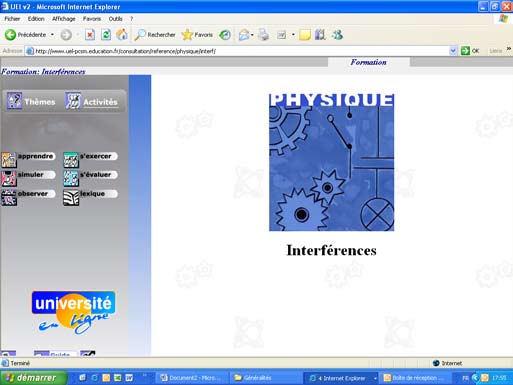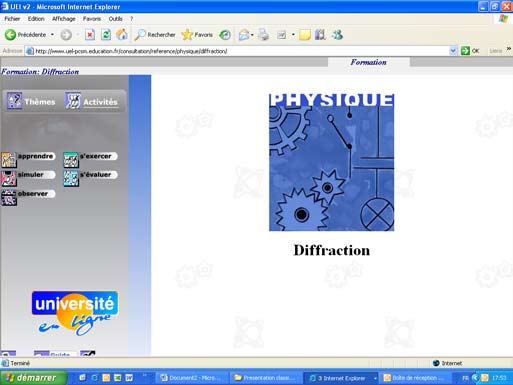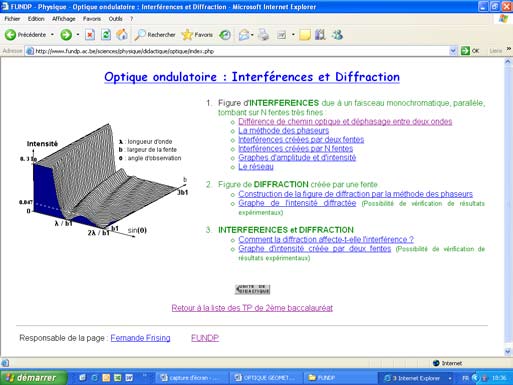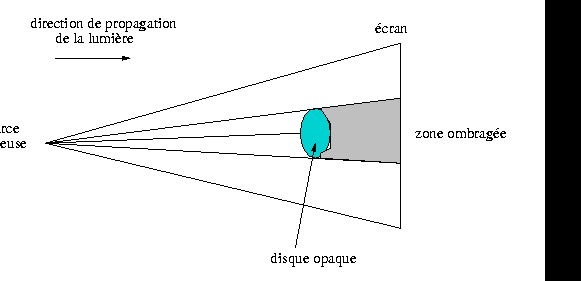African Virtual University
Useful Link #7
Title : Systèmes oscillants (Oscillatory Systems)
URL : http://www.uel-pcsm.education.fr/consultation/reference/physique/syst_
oscillants/index.htm
Screenshot :
Description: This is a very complete site for understanding the behavior of
oscillatory systems. On it you can find many headings : ‘apprendre (learning)’
course framework, ‘s’exercer (practice)’ gives exercises for each chapter, ‘s’éva-
luer (evaluate)’ presents self-evaluations.
Justification: This very comprehensive site allows you to acquire the necessary
knowledge to master an oscillator’s different characteristics. Solving general
oscillating system equations allow the comprehension of the analogy between
oscillators independently from the nature of the pulse.


African Virtual University
Useful Link #8
Title : Interférences (Interference)
URL : http://www.uel-pcsm.education.fr/consultation/reference/physique/in-
terf/
Screenshot :
Description: This is a very complete site for understanding and interpreting the
conditions that are essential to producing an interference, along with its cha-
racteristics. On it you can find many headings : ‘apprendre (learning)’ course
framework, ‘simuler (simulate)’ access to QuickTime animations and Flash or
Java simulations, ‘observer (observe)’ access to experiment movies, ‘s’exercer
(practice)’ gives exercises for each chapter, ‘s’évaluer (evaluate)’ presents self-
evaluations.
Justification: This very comprehensive site allows you to acquire the necessary
knowledge to master the different characteristics related to interferences. A hi-
ghlight of this website is the use of Fresnel representations (or phasers according
to certain authors) as well as analytical calculations.


African Virtual University
Useful Link #9
Title :Diffraction (Diffraction)
URL : http://www.uel-pcsm.education.fr/consultation/reference/physique/dif-
fraction/
Screenshot :
Description: This is a very complete site for understanding diffraction cha-
racteristics. On it you can find many headings : ‘apprendre (learning)’ course
framework, ‘simuler (simulate)’ access to QuickTime animations and Flash or
Java simulations, ‘observer (observe)’ access to experiment movies, ‘s’exercer
(practice)’ gives exercises for each chapter, ‘s’évaluer (evaluate)’ presents self-
evaluations.
Justification: This very comprehensive site allows you to acquire the necessary
knowledge to master diffraction characteristics. The highlight of this site is the gra-
phical representation of each phenomenon using the results that were obtained.


African Virtual University 0
Useful Link #10
Title : Optique ondulatoire : Interférences et Diffraction (Wave Optics :
Interference and Diffraction)
URL : http://www.fundp.ac.be/sciences/physique/didactique/optique/index.php
Screenshot :
Description: Following a short review, this site defines the necessary conditions
for producing interferences and diffraction. A simulation allows you to highlight
the evolution of an interference or diffraction pattern. The variables can be mo-
dified, thus allowing you to observe the way an interference evolves.
Justification: The different simulations provide a better understanding of how
to construct interference or diffraction figures. It is possible to observe all of a
slit’s diffraction characteristics since you are able to change the slit’s width, the
focal length and the wavelength.

African Virtual University
XIV. learning activities
Learning Activity 1
Activity Title
Geometrical Optics Basic
Required Time
4 hours
Specific Objectives
•
Recognize the characteristic magnitudes of a light wave
•
Recite Descartes’ Laws
•
Describe the concept of a ray of light
•
Describe the characteristics for an image created by an optical system
Activity Summary
Through this activity, you will learn how the concept of optics and, later on, of
light and similar phenomena has changed, even when the phenomena cannot be
directly detected by human beings. The history about the way optics laws were
developed will help you understand the different steps required to establish current
knowledge and applications. This has helped information technology progress
rapidly: lasers, fiber optics... Those elements will allow us to define conditions
and limitations for geometrical optics related laws and principles. You will then
have to identify and categorize the different natures of optical system objects
and images.
Key Concepts
Optics: For close to two thousand years, the study of optics is considered to be
a field that specializes in the phenomena that are seen by the eye. Its main goal
is to research vision mechanisms, but starting in the XVIIth century, it begins to
include all that concerns light and similar phenomena, even when the phenomena
cannot be directly detected by human beings.
Light Waves can be considered as the stacking of monochromatic (of a single
colour) sinusoidal waves.

African Virtual University
A medium’s refractive index (n) is the relation between the speed of light (c)
in a vacuum and the speed of light (v) in the medium.
Diffraction is the way a wave behaves when confronted with an obstacle that is
not completely transparent to it. (vague diffraction and may be misleading.)
The incidence point I is the spot where a ray of light meets the boundary between
two media.
Activity Description
This educational activity consists of understanding the evolution of the way light
and similar phenomena have been understood. To do so, knowledge of a brief
history of the development of optics laws will allow an understanding of the
necessity to define the limitations and conditions for establishing geometrical
optics laws and principles. To gain a better understanding of the problem you will
need to learn characteristic light wave magnitudes, understand the reason certain
bodies are white, colored or black depending on the nature of the environment.
The comprehension of the concept of a light wave is essential since it will al-
low us to characterize the limitations of geometrical optics. The more elaborate
principles and laws will be addressed in physical optics to show that geometrical
optics is an approximation of a more extensive concept. Since the laws and rules
of optics will mostly be applied to optical instruments, from a lighthouse mirror
to a microscope, we will need to familiarize ourselves with the nature of optical
system objects and images (real or virtual).
Relevant Reading
HERIMANDA A. RAMILISON (2006) : Fondements de l’optique géométrique.
Madagascar. Antanarivo University. Unpublished course. (Give more accessible
relevant reading)
Reading Summary
It includes a brief history of optics and emphasizes the eye’s sensitivity limitations
which are limited to visible wavelengths. In spite of ALHAZEN (965-1039),
an Arabian physicist who was the first to understand that the eye does not emit
rays that examine objects, but that objects themselves, when illuminated by a
source, are at the origin of rectilinear rays, popular belief, that a hypnotist is able
to submit people to his will simply with the ‘power’ of his gaze, still persists.
This course will show us that geometrical optics is nothing but an approximation
of wave theory. A better understanding of the concept of a beam or ray of light
will be obtained with this theory and it will help us to comprehend the different
principles and limits related to geometrical optics. The laws of optics that will
be introduced here might be ancient, but they have the merit of being based on
simple observations. This course will familiarize us with the nature of objects
and images.

African Virtual University
Reading Justification
This reading will help readers comprehend the justifications and limitations so
that they may:
•
understand the necessary conditions that result in nearsighted astigma-
tism;
•
familiarize themselves with the nature of objects and images.
•
know the definitions of concepts such as: ray of light, incidence point,
reflection, refraction, etc.
Useful Links (Give relevant links in English also)
http://www.sciences.univ-nantes.fr/physique/enseignement/DeugA/Physique1/
optique/cours/chap1.html#x1-92005
http://www.uel-pcsm.education.fr/consultation/reference/physique/optigeo/
menumodule/menuthemes/menu_reduit.html
http://www.univ-Lemans.fr/enseignements/physique/02/optigeo/
http://fr.wikipedia.org/wiki/Optique
http://cours.cegep-st-jerome.qc.ca/203-301-r.f/prtie2/chap6/default.htm

African Virtual University
Activity Introduction
You are in the dark, you cannot see at all. To be able to see you need to light
a candle, for example. To do so you strike a match, then you burn the candle’s
wick with the match’s flame. You then notice that the candle’s light projects
your shadow onto the wall. These elements emphasize the point that the Arabian
physicist ALHAZEN (965-1039) was trying to get across; that the eye does not
emit rays that examine objects, but that objects themselves, when illuminated
by a source, are at the origin of rectilinear rays. The demonstration we just did
seems quite elementary but it is not, since it has taken a long time to end up with
the knowledge we have now.
Formative Evaluation
1) Draw a sketch, with commentary, that emphasizes the fact that the shadow of
an opaque disc projected onto a screen is homothetic (not clear in English) to
the object no matter what the distance between the disc and the screen is.
2) Complete the following sentence: A beam of light is composed of rectilinear
………………
3) Is it possible to separate a ray of light from a beam of light?
4) How many geometrical optics laws exist? Detail these laws using a dia-
gram.
Learning Activities
To answer the following questions the learners must:
•
Read all the recommended readings
•
Complete all of the exercises with clear and precise diagrams
• Organize themselves into a collaborative work group
The group members will work together to solve each exercise. Each group will
designate a spokesperson; the spokespersons from every group will then share
the answers to each exercise through chatting, under the guidance of a tutor. The
tutor will be able to let them know when the correct answer for a question has
been found and will suggest that they continue on to the next exercise.
When all of the problems are solved, the chat window is closed. Since the dis-
cussions are recorded, the tutor will be able to review the chat session at any time
and tell which group suggested the best solutions through each spokesperson.
































































































































![]()













































































































































